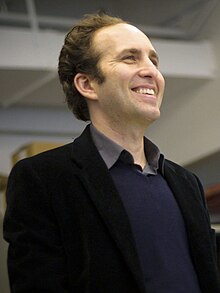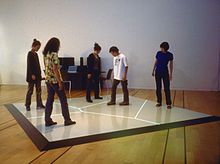
Digital art refers to any artistic work or practice that uses digital technology as part of the creative or presentation process. It can also refer to computational art that uses and engages with digital media.

Electronic art is a form of art that makes use of electronic media. More broadly, it refers to technology and/or electronic media. It is related to information art, new media art, video art, digital art, interactive art, internet art, and electronic music. It is considered an outgrowth of conceptual art and systems art.

Golan Levin is an American new media artist, composer, performer and engineer interested in developing artifacts and events which explore supple new modes of reactive expression.
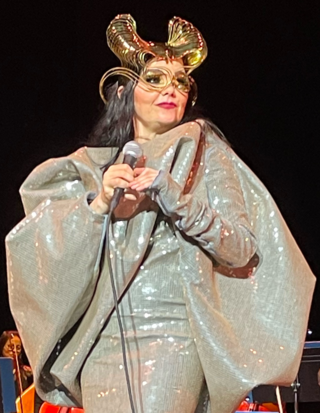
Björk Guðmundsdóttir is an Icelandic singer, songwriter, composer, record producer, and actress. Noted for her distinct voice, three-octave vocal range, and sometimes eccentric public persona, she has developed an eclectic musical style over a career spanning four decades, drawing on electronic, pop, experimental, trip hop, classical, and avant-garde music.
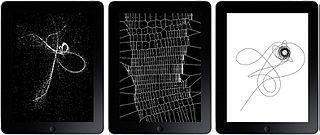
iPhone art is a form of Interactive art that takes place on the screen of the iPhone, iPad, or iPod Touch. It is distinct from pictorial works of art produced with an iPhone using paint apps such as Brushes or ArtRage.

Biophilia is the seventh studio album by Icelandic singer Björk. It was released on 5 October 2011 by One Little Indian Records and distributed by Nonesuch Records in North America and by Universal Music Group in the rest of the world. Björk composed it as a concept album during the 2008–2011 Icelandic financial crisis, exploring the links between nature, music and technology. Billed as the first "app album", Biophilia is a multimedia project released alongside a series of apps linking the album's themes to musicology concepts. It was followed by a series of educational workshops on four continents.
Drew Berry is an American biomedical animator at the Walter and Eliza Hall Institute of Medical Research in Melbourne, Australia. He produces animations of proteins and protein complexes to illustrate cellular and molecular processes.

OscilloScoop is an interactive music app for iOS that runs on the iPad, iPhone, and iPod Touch, available through the iTunes App Store. The app presents a real-time interface for creating electronic music in various electronic music genres from hip hop to techno and house. The app is designed with a minimalist modern interface of three colored crowns, that spin like potters' wheels. Touching each crown affects the parameters of the audio. The top crown controls pitch, the middle a low pass resonant filter, and the bottom a fader. Controls on the left allow one to change the bassline beat, while buttons on the right allow the user to save their creation, and a slider below controls tempo.

"Crystalline" is a song by Icelandic artist Björk, released as the lead single from her eighth album Biophilia. The song was released as a single on 28 June 2011 accompanied by an iPad app developed exclusively for the song. It was afterward released as part of The Crystalline Series alongside the second single from the album, "Cosmogony".
"Mutual Core" is a song recorded by Icelandic singer Björk for her seventh studio album Biophilia (2011). It was written and produced by Björk herself, while programming and beats were made in collaboration with Matthew Herbert and the English dubstep band 16bit. "Mutual Core" is an uptempo experimental song. Its music includes Pipe organ, electronica-tinged sounds and features the Choir Graduale Nobili, the choir featured on Biophilia. The song's lyrics are a metaphor for human relationships, compared to the structure of the Earth and Plate tectonics. The song was well received by contemporary music critics, who praised its production and beats, moreover appreciating Björk's voice on the track.
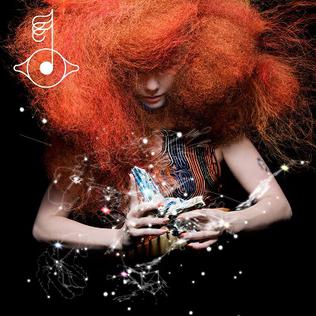
"Cosmogony" is a song by Icelandic artist Björk, released as the second single from her eighth album Biophilia. The song was released on iTunes on July 19, 2011. It was also released as an app, which served as the "mother app" for the Biophilia app. It was released as part of The Crystalline Series alongside the first single from the album "Crystalline" on CD and vinyl.
Max Weisel is an American software engineer and digital artist. His experience as an iOS app developer predates the release of Apple's App Store. He's collaborated with avant garde artist Björk, to produce Biophilia, the first full-length app album. In addition his work has been featured in museums such as the New York Museum of Modern Art. He is the founder of the San Francisco-based research and development company RelativeWave, which was acquired by Google in 2014.
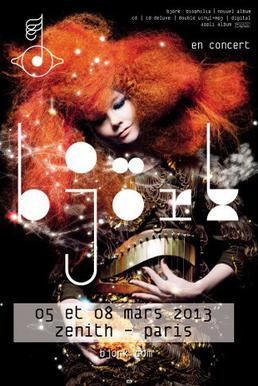
The Biophilia Tour was the seventh concert tour by Icelandic musician Björk. The tour was centered on her multimedia project and studio album Biophilia (2011). The tour premiered at the Manchester International Festival and visited Europe, Americas, Asia, including her first visit to Taiwan, and featured the first performance in Africa.
Universal Everything is a digital art practice and design studio based in Sheffield, England. The studio was founded in 2004 by Matt Pyke, who is the creative director. Pyke studied botanical and technical illustration and then graphic design, before spending eight years at the Designers Republic (1996–2004).
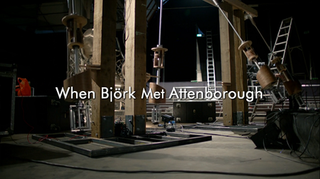
When Björk Met Attenborough is a 2013 documentary television film directed by Louise Hooper, executive produced by Lucas Ochoa and produced by Caroline Page. It was aired for the first time on 27 July 2013 on Channel 4, in conjunction with Pulse Films and One Little Indian Records. Partly filmed at the Natural History Museum in London, the documentary features an encounter between Icelandic singer-songwriter and musician Björk and English broadcaster and naturalist David Attenborough. They discuss the nature of music and the intersection between music, nature and technology. It also follows the singer as she prepares for her Biophilia Tour, along with rehearsal and studio recording.

Ars Electronica Linz GmbH is an Austrian cultural, educational and scientific institute active in the field of new media art, founded in Linz in 1979. It is based at the Ars Electronica Center (AEC), which houses the Museum of the Future, in the city of Linz. Ars Electronica's activities focus on the interlinkages between art, technology and society. It runs an annual festival, and manages a multidisciplinary media arts R&D facility known as the Futurelab. It also confers the Prix Ars Electronica awards.
Tilt Brush is a room-scale 3D-painting virtual-reality application available from Google, originally developed by Skillman & Hackett.

Franz Fischnaller is a new media artist and transdisciplinary researcher. He is recognized for the creation of his digital, virtual reality and interactive art installations works across the fields of art, technology, humanities and cultural heritage.
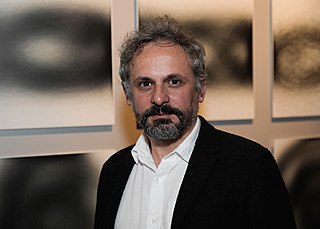
Mauro Martino is an Italian artist, designer and researcher. He is the founder and director of the Visual Artificial Intelligence Lab at IBM Research, and Professor of Practice at Northeastern University.

Eyegroove was a social media service headquartered in San Francisco for creating short music videos with augmented reality effects founded by Scott Snibbe and Graham McDermott. The company was established in 2013 and released the first version of its app on iOS that year. Through the app, users could create thirty second creative and lip-syncing music videos and choose musical tracks to accompany them, use different speed options and add time-based augmented reality filters and effects. The app's social media features included an Instagram-like feed, hashtags for creative memes, user tagging, and comment threads.
